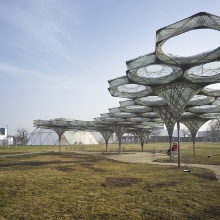With the exhibition »Hello, Robot. Design between Human and Machine« the Vitra Design Museum presents a major exhibition that focuses on the current boom in robotics. The »Elytra Filament Pavilion« continues the exhibition outside the museum building. The 200m² structure is inspired by lightweight construction principles found in nature – the fibrous structures of the forewing shells of flying beetles known as elytra.
The Institute for Computational Design is a Pioneer in its Field
With the robotic construction technique used at the Institute for Computational Design (ICD), architects Achim Menges and Moritz Dörstelmann, construction engineer Jan Knippers and climate engineer Thomas Auer have produced truly pioneering work at the University of Stuttgart. The technology was developed as the result of years of research and employs new robotic winding methods to use the extraordinary load-bearing properties of carbon fibers and give them strength as woven structural components.
Every Cell and Every Column is Unique
The characteristic shape of the pavilion comprises a series of cell-like modules. These weigh approximately 45 kg on average and can be produced in just three hours. The cells and their seven supporting columns were produced by a computer-programed Kuka robot during a four-month construction process at the ICD‘s Computational Construction Laboratory in Stuttgart. The robot wound resin-soaked glass and carbon fibers onto a hexagonal scaffold. Each cell and each column is unique. The final form is caused by the changing stress conditions determined by structural stimulation carried out in advance by the ITKE. The result is an exceptionally light structure, weighing less than 9kg per square meter – the entire pavilion weighs in at 2.5 tons.
A Glimpse of the Future
With the »Elytra Filament Pavilion« we wanted to explore a truly new way of integrating form, material, structure at the interface of computer-based design and robotic production. This creates a unique spatial and aesthetic experience. The pavilion grows and responds to real-time data, thus showcasing the influence of digital technologies and new alliances between the fields of design, engineering and natural science. We seek to provide visitors with a unique experience and also offer a glimpse of new possibilities that may transform our built environment in the future”, says Achim Menges.
Further information:
For further information about the exhibition »Elytra Filament Pavilion« please contact:
Institute for Computational Design and Construction
Moritz Doerstelmann
For further information about the exhibition »Hello, Robot. Design between Human and Machine« please contact:
Vitra Design Museum
Iris Mickein, Head of Communications


